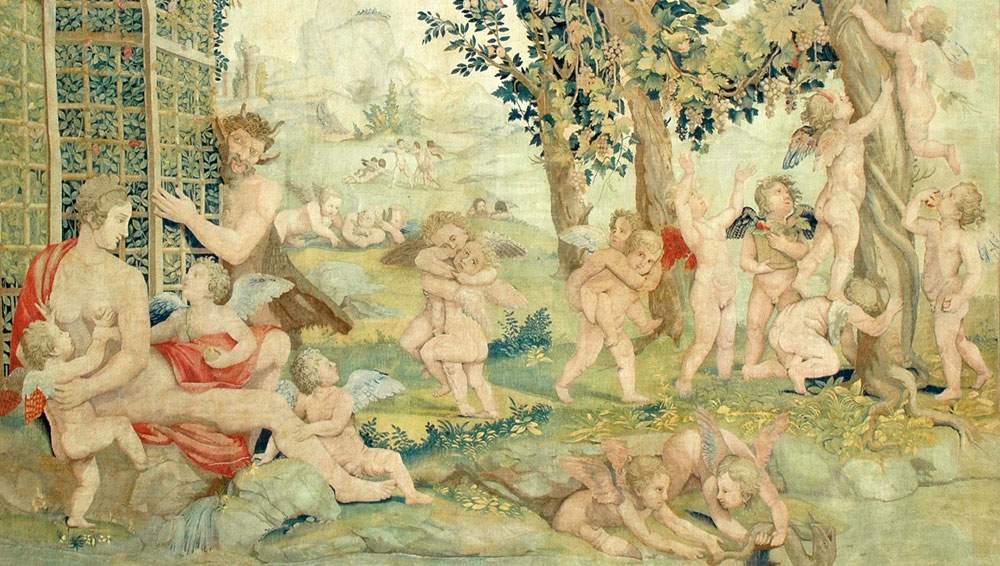Monumental Renaissance tapestry purchased by MiBACT returns to the Ducal Palace in Mantua
Back in the Ducal Palace in Mantua is a Renaissance masterpiece purchased by MiBACT thanks to the General Directorate for Museums, the Mantuan Ducal Palace and the support of Fondazione Palazzo Te: a tapestry made between 1539 and 1540 commissioned by Federico II Gonzaga. Huge in size (more than four meters high and about four and a half meters wide), the tapestry adds to the Ducal Palace museum’s remarkable collection. The central scene depicted on the tapestry is taken from a classical text by Philostratus from the second century CE and shows Venus being spied on by a satyr, with a series of cherubs animating the lively scene. The invention of the scene is due to Giulio Romano, while the making of the tapestry is the work of Nicolas Karcher, a great tapestry maker active in Italy at the time. The work was a sort of sample of Karcher’s skills specially called to Mantua by Federico II Gonzaga to establish a real tapestry workshop. The tapestry is the first in a series completed by Cardinal Ercole Gonzaga after Federico II Gonzaga’s death in 1540.
“Securing this tapestry in Mantua,” said Ducal Palace director Stefano L’Occaso, “is a great achievement, achieved as the seal of a complex negotiation. I want to express my gratitude first of all to the General Directorate for Museums, but also to the commitment of the previous director of Palazzo Ducale Emanuela Daffra and to the decisive support of the Fondazione di Palazzo Te; our board of directors and auditors were also of great help. The negotiations were not concluded until just before Christmas, and today a gang of lively winged cherubs, dominating the lush naturalistic setting, takes over the Ducal Palace. Those wild children almost leave the figure of Venus and the satyr spying on her from behind the pergola on the sidelines. A voyeuristic image, but also an erudite display, the product of Giulio Romano’s vivid imagination and beautifully rendered by the skill of the weaver. Everything combines to make this tapestry a manifesto of that Golden Age that was the duchy of Federico II Gonzaga.”
The work, which undoubtedly belonged to the Gonzagas for at least the entire seventeenth century, only resurfaced in the early twentieth century in Vienna: around 1972 it was reported in London on the antiques market and was purchased by Federico Zeri. It was he himself who understood the importance of this tapestry, which was then displayed in 1989 at the major exhibition held in Mantua on Giulio Romano (curated by Ernest H. Gombrich and Manfredo Tafuri). When Federico Zeri died, the tapestry passed to his heirs and then to the collector Raffaele Verolino from whom it was purchased by the state.
“I acquired Giulio Romano’s tapestry Venus spied on by a satyr with cherubs in 2004,” collector Raffaele Verolino recounted, "from Federico Zeri’s heirs; the work showed a serious textile and chromatic degradation, there were detachments and losses along the lower border, moreover the colors had been partly covered by paint overlays. All this had already been pointed out by Prof. Nello Forti Grazzini in the catalog of the Giulio Romano exhibition held at the Ducal Palace in Mantua in 1989, where the work was exhibited. I can therefore say that the restoration of the tapestry was a “gamble”; no one wanted to take on the commitment because it was judged too risky and onerous. After more than a year of restoration, however, the gamble was won, the result left everyone pleasantly impressed as I had succeeded in bringing to light a work fundamental to the “series” of Mantuan tapestries commissioned by Federico II Gonzaga. The first exhibition opportunity was at Palazzo Te in Mantua in 2010 for the exhibition on the Gonzaga tapestries, “The Gonzaga Tapestries in the Renaissance,” and here the work was shown together with the other tapestries in the series, the only example belonging to a private gallery. I was then contacted in September 2018 by the then director Peter Assmann to have it, as the only tapestry, in the Giulio Romano exhibition with new and extravagant manner at the Ducal Palace. I gladly agreed to lend my tapestry to the Doge’s Palace, and before the end of the exhibition a purchase proposal was made to me, which I accepted after long negotiations, which ended in December of last year."
It is a masterpiece of great importance for the patron, for the subject, for its creator Giulio Romano, and for the tapestry maker who made it. For all that, it is very important that the tapestry has returned to Mantua, to the city where it was conceived.
Pictured: Manufacture by Nicolas Karcher on cartoon by Giulio Romano, Venus spied by a satyr with cherubs (1539-1540; wool and silk tapestry; 410 × 450 cm) © Gian Maria Pontiroli for Fondazione Palazzo Te
 |
| Monumental Renaissance tapestry purchased by MiBACT returns to the Ducal Palace in Mantua |
Warning: the translation into English of the original Italian article was created using automatic tools. We undertake to review all articles, but we do not guarantee the total absence of inaccuracies in the translation due to the program. You can find the original by clicking on the ITA button. If you find any mistake,please contact us.



























